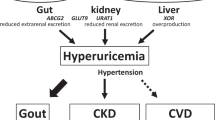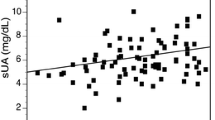Abstract
Objective and design
Insulin resistant Otsuka–Long–Evans–Tokushima Fatty (OLETF) and its control Long–Evans Tokushima Ohtsuka (LETO) rats were used to generate a model for acute hyperuricemia. Upon the onset of insulin resistance OLETF rats were feed with high-purine diet, and the development of acute hyperuricemic renal injury and gouty-like lesions was monitored. Rosiglitazone was also administered to demonstrate whether improved insulin sensitivity would prevent high-purine diet induced renal injury and gouty-like lesions.
Results
Otsuka–Long–Evans–Tokushima Fatty rats showed significant higher incidence of hyperuricemia as compared to the control LETO rats (77 vs. 36.1%, P < 0.05), indicating that insulin resistance exacerbates the development of hyperuricemia following high-purine load. Consistent with this observation, improvement of insulin sensitivity by administration of rosiglitazone significantly reduced high-purine diet induced renal injury and gouty-like lesions. It was found that insulin resistance is associated with impaired capability for maintaining the homeostasis of renal uric acid excretion and reabsorption. Upon high-purine load, insulin resistance enhances urate reabsorption as manifested by up-regulated URAT1 expression and reduces urate excretion as characterized by down-regulated UAT expression.
Conclusions
Our data demonstrated strong evidence indicating that insulin resistance acts as an independent risk factor predisposing OLETF rats more susceptible to the development of hyperuricemia and gouty arthritis following high-purine load.






Similar content being viewed by others
References
Miao Z, Li C, Chen Y, Zhao S, Wang Y, Wang Z, Chen X, Xu F, Wang F, Sun R, Hu J, Song W, Yan S, Wang CY. Dietary and Lifestyle changes associated with high prevalence of hyperuricemia and gout in the Shandong Coastal Cities of Eastern China. J Rheumatol. 2008;35(9):1859–64.
Tsouli SG, Liberopoulos EN, Mikhailidis DP, Athyros VG, Elisaf MS. Elevated serum uric acid levels in metabolic syndrome: an active component or an innocent bystander? Metabolism. 2006;55:1293–301.
Fam AG. Gout: excess calories, purines, and alcohol intake and beyond. Response to a urate-lowering diet. J Rheumatol. 2005;32:773–7.
Fam AG. Gout, diet, and the insulin resistance syndrome. J Rheumatol. 2002;29:1350–5.
Snaith ML. Gout: diet and uric acid revisited. Lancet. 2001;358:525.
Bayani-Sioson PS, Skeith M, Healey LS Jr. On Filipino hyperuricemia. Acta Med Philipp. 1966;3:126–7.
Choi HK, Atkinson K, Karlson EW, Willett W, Curhan G. Purine-rich foods, dairy and protein intake, and the risk of gout in men. N Engl J Med. 2004;350:1093–103.
Choi HK, Liu S, Curhan G. Intake of purine-rich foods, protein, and dairy products and relationship to serum levels of uric acid: the Third National Health and Nutrition Examination Survey. Arthritis Rheum. 2005;52:283–9.
Huang Y, Yin H, Han J, Huang B, Xu J, Zheng F, et al. Extracellular hmgb1 functions as an innate immune-mediator implicated in murine cardiac allograft acute rejection. Am J Transplant. 2007;7:799–808.
Okauchi N, Mizuno A, Yoshimoto S, Zhu M, Sano T, Shima K. Is caloric restriction effective in preventing diabetes mellitus in the Otsuka Long Evans Tokushima fatty rat, a model of spontaneous non-insulin-dependent diabetes mellitus? Diabetes Res Clin Pract. 1995;27:97–106.
Okauchi N, Mizuno A, Zhu M, Ishida K, Sano T, Noma Y, et al. Effects of obesity and inheritance on the development of non-insulin-dependent diabetes mellitus in Otsuka-Long-Evans-Tokushima fatty rats. Diabetes Res Clin Pract. 1995;29:1–10.
Hediger MA, Johnson RJ, Miyazaki H, Endou H. Molecular physiology of urate transport. Physiology (Bethesda). 2005;20:125–33.
Ichida K, Hosoyamada M, Hisatome I, Enomoto A, Hikita M, Endou H, et al. Clinical and molecular analysis of patients with renal hypouricemia in Japan-influence of URAT1 gene on urinary urate excretion. J Am Soc Nephrol. 2004;15:164–73.
Leal-Pinto E, Tao W, Rappaport J, Richardson M, Knorr BA, Abramson RG. Molecular cloning and functional reconstitution of a urate transporter/channel. J Biol Chem. 1997;272:617–25.
Leal-Pinto E, Cohen BE, Abramson RG. Functional analysis and molecular modeling of a cloned urate transporter/channel. J Membr Biol. 1999;169:13–27.
Leal-Pinto E, Cohen BE, Lipkowitz MS, Abramson RG. Functional analysis and molecular model of the human urate transporter/channel, hUAT. Am J Physiol Renal Physiol. 2002;283:F150–63.
Lin WY, Liu CS, Li TC, Lin T, Chen W, Chen CC, et al. In addition to insulin resistance and obesity, hyperuricemia is strongly associated with metabolic syndrome using different definitions in Chinese populations: a population-based study (Taichung Community Health Study). Ann Rheum Dis. 2008;67:432–3.
Chen LK, Lin MH, Lai HY, Hwang SJ, Chiou ST. Uric acid: a surrogate of insulin resistance in older women. Maturitas. 2008;59:55–61.
Bonora E, Capaldo B, Perin PC, Del PS, De MG, Frittitta L, Frontoni S, Leonetti F, Luzi L, Marchesini G, Marini MA, Natali A, Paolisso G, Piatti PM, Pujia A, Solini A, Vettor R, Bonadonna RC. Hyperinsulinemia and insulin resistance are independently associated with plasma lipids, uric acid and blood pressure in non-diabetic subjects. The GISIR database. Nutr Metab Cardiovasc Dis 2008;18:624–31.
Lin JD, Chiou WK, Chang HY, Liu FH, Weng HF. Serum uric acid and leptin levels in metabolic syndrome: a quandary over the role of uric acid. Metabolism. 2007;56:751–6.
Choi HK, Ford ES. Prevalence of the metabolic syndrome in individuals with hyperuricemia. Am J Med. 2007;120:442–7.
Souza AV, Petretski JH, Demasi M, Bechara EJ, Oliveira PL. Urate protects a blood-sucking insect against hemin-induced oxidative stress. Free Radic Biol Med. 1997;22:209–14.
Funakoshi A, Miyasaka K, Jimi A, Kawanai T, Takata Y, Kono A. Little or no expression of the cholecystokinin-A receptor gene in the pancreas of diabetic rats (Otsuka Long-Evans Tokushima Fatty = OLETF rats). Biochem Biophys Res Commun. 1994;199:482–8.
Hashimoto H, Onaka T, Kawasaki M, Chen L, Mera T, Soya A, et al. Effects of cholecystokinin (CCK)-8 on hypothalamic oxytocin-secreting neurons in rats lacking CCK-A receptor. Auton Neurosci. 2005;121:16–25.
Miyasaka K, Kanai S, Ohta M, Kawanami T, Kono A, Funakoshi A. Lack of satiety effect of cholecystokinin (CCK) in a new rat model not expressing the CCK-A receptor gene. Neurosci Lett. 1994;180:143–6.
Moran TH, Ameglio PJ, Schwartz GJ, McHugh PR. Blockade of type A, not type B, CCK receptors attenuates satiety actions of exogenous and endogenous CCK. Am J Physiol. 1992;262:R46–50.
Chen X, Pang Z, Li K. Dietary fat, sedentary behaviors and the prevalence of the metabolic syndrome among Qingdao adults. Nutr Metab Cardiovasc Dis 2009;19:27–34.
Bao Y, Lu J, Wang C, Yang M, Li H, Zhang X, Zhu J, Lu H, Jia W, Xiang K. Optimal waist circumference cutoffs for abdominal obesity in Chinese. Atherosclerosis 2008;201:378–84.
Mi J, Cheng H, Zhao XY, Hou DQ, Chen FF, Zhang KL. Developmental origin of metabolic syndrome: interaction of thinness at birth and overweight during adult life in Chinese population. Obes Rev. 2008;9 suppl 1:91–4.
Li Y, Yang X, Zhai F, Piao J, Zhao W, Zhang J, et al. Childhood obesity and its health consequence in China. Obes Rev. 2008;9(suppl 1):82–6.
Nan H, Qiao Q, Soderberg S, Gao W, Zimmet P, Shaw J, et al. Serum uric acid and components of the metabolic syndrome in non-diabetic populations in Mauritian Indians and Creoles and in Chinese in Qingdao, China. Metab Syndr Relat Disord. 2008;6:47–57.
Nan H, Qiao Q, Dong Y, Gao W, Tang B, Qian R, et al. The prevalence of hyperuricemia in a population of the coastal city of Qingdao, China. J Rheumatol. 2006;33:1346–50.
Acknowledgments
This work was supported by grants from the National Science Foundation of China (NSFC 30470821 to Z. Miao and NSFC 30570890 to C. Li), and partly supported by NIH to C.-Y. Wang.
Conflict of interest statement
The authors have declared no conflicts of interest.
Author information
Authors and Affiliations
Corresponding authors
Additional information
Responsible Editor: S. A. Stimpson.
Rights and permissions
About this article
Cite this article
Miao, Z., Yan, S., Wang, J. et al. Insulin resistance acts as an independent risk factor exacerbating high-purine diet induced renal injury and knee joint gouty lesions. Inflamm. Res. 58, 659–668 (2009). https://doi.org/10.1007/s00011-009-0031-9
Received:
Revised:
Accepted:
Published:
Issue Date:
DOI: https://doi.org/10.1007/s00011-009-0031-9




